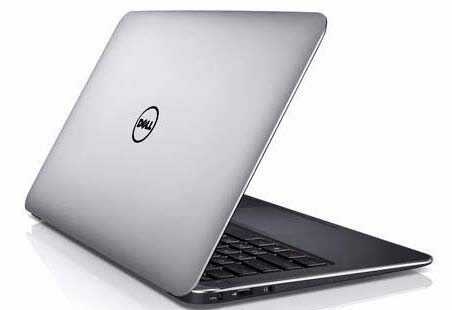Of the Ultrabooks released so far, the Asus Zenbook UX31 has been the best. Despite the terrible track pad, it offers Core-17 goodness and a fantastic design for £999, while you can get the 11.6-inch UX21 version for £800.
Dell hasn’t been quick to get into the market, but it has waited for rivals to make their move-something that
could play to its advantage. Like many Ultrabooks, the XPS 13 certainly turns heads. From the outside, it looks like a smaller version of the Dell XPS 15z and Dell XPS 14z, which is no bad thing. Its curvaceous silver aluminium shell clocks in at a feather-weight 1.4kg.
Dell hasn’t been quick to get into the market, but it has waited for rivals to make their move-something that
could play to its advantage. Like many Ultrabooks, the XPS 13 certainly turns heads. From the outside, it looks like a smaller version of the Dell XPS 15z and Dell XPS 14z, which is no bad thing. Its curvaceous silver aluminium shell clocks in at a feather-weight 1.4kg.
The first thing that strikes you about the XPS 13 is how compact it is. Despite it being a 13-inch display, the 31.6 x 20.5cm footprint is narrow and Dell makes no secret of its desire to be smaller than the 13-inch MacBook Air but with a similar screen size. It really is a gorgeous-looking device.
Once you lift the lid and peer inside, you really see the lengths Dell has gone to with the XPS 13. The finish is superb. The interior is coated with a soft rubber surface that feels comfortably like the inside of an expensive car.
Standing out from the rubber coating is the centrally placed glass multi-gesture touchpad, which features integrated mouse buttons, similar to the Acer Aspire S. While this doesn’t offer the best usability, we’ll concede that these buttons are aesthetically more appealing.
Because of the thinness of the chassis, the keyboard here like other Ultrabooks - has a very shallow travel. This isn’t too much of an issue though and the spacing of the slightly curved keys is well proportioned. The keyboard is also backlit, which is a major miss from the Zenbook.
Once you lift the lid and peer inside, you really see the lengths Dell has gone to with the XPS 13. The finish is superb. The interior is coated with a soft rubber surface that feels comfortably like the inside of an expensive car.
Standing out from the rubber coating is the centrally placed glass multi-gesture touchpad, which features integrated mouse buttons, similar to the Acer Aspire S. While this doesn’t offer the best usability, we’ll concede that these buttons are aesthetically more appealing.
Because of the thinness of the chassis, the keyboard here like other Ultrabooks - has a very shallow travel. This isn’t too much of an issue though and the spacing of the slightly curved keys is well proportioned. The keyboard is also backlit, which is a major miss from the Zenbook.
 |
| Tech Spec: Cpu Intel Core i7-2637M © 1.7MHz Memory 4GB 1.333MHz single-channel DDR3 Storage 25 6GB SSD Graphics Intel HD 3000 OS Windows Home Premium 64-bit |
Intel inside
While the exterior is certainly pleasing the interior does a decent job of matching it. Our model came sporting a hyper-threaded, dual-core 1.7GHz 17-2637M. This is the top-end chip available inside the £1,299 version of the unit. Another HT dual-core 1.6GHz Core i5-2467M is available inside the £1,149 model, while the £949 system boasts the same CPU but with a smaller 128GB SSD. All the chips are fine processors from Intel’s Sandy Bridge line-up.
The XPS 13 looks and feels stunning and performance is also just about on a par with what we would expect from an Ultrabook. However, we were slightly disappointed with the 177 minutes of battery life. The Zenbook UX31 provides over four hours. It’s unusual too that Dell has chosen to use DisplayPort as an output. We can see this makes sense for some users-notably those in corporate environments-and, of course, the MacBook Air has Thunderbolt, but we’d have thought a mini-HDMI would make more sense.
Sadly though the Dell XPS 13’s key decider is its price. The £949 model will be more than enough for most, but with the Core i7 version of the Asus Zenbook UX31 now down to £999, it really does have its work cut out, especially because the UX31 has a faster 1.8GHz processor than the 1.7GHz £1,200 version of the Dell XPS 13 (Dan Grabham / PCF)
The XPS 13 looks and feels stunning and performance is also just about on a par with what we would expect from an Ultrabook. However, we were slightly disappointed with the 177 minutes of battery life. The Zenbook UX31 provides over four hours. It’s unusual too that Dell has chosen to use DisplayPort as an output. We can see this makes sense for some users-notably those in corporate environments-and, of course, the MacBook Air has Thunderbolt, but we’d have thought a mini-HDMI would make more sense.
Sadly though the Dell XPS 13’s key decider is its price. The £949 model will be more than enough for most, but with the Core i7 version of the Asus Zenbook UX31 now down to £999, it really does have its work cut out, especially because the UX31 has a faster 1.8GHz processor than the 1.7GHz £1,200 version of the Dell XPS 13 (Dan Grabham / PCF)
